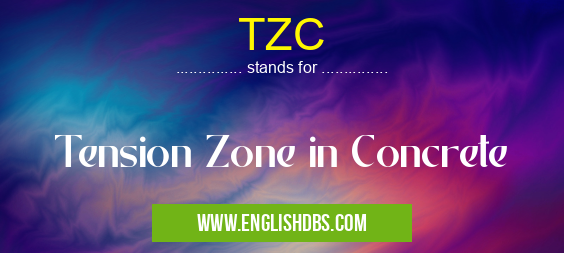What does TZC mean in ENGINEERING
TZC stands for Tension Zone in Concrete. It refers to the region within a concrete structure where tensile stresses exceed the tensile strength of the concrete, causing it to crack. Understanding TZC is crucial in structural engineering to ensure the integrity and safety of concrete structures.

TZC meaning in Engineering in Academic & Science
TZC mostly used in an acronym Engineering in Category Academic & Science that means Tension Zone in Concrete
Shorthand: TZC,
Full Form: Tension Zone in Concrete
For more information of "Tension Zone in Concrete", see the section below.
Causes of TZC
Tensile stresses can arise in concrete due to various factors, such as:
- External loads: Forces applied on the structure, such as weight, wind, or seismic forces.
- Shrinkage: Concrete shrinks as it cures, creating tensile stresses within the material.
- Thermal expansion: Changes in temperature can cause differential thermal expansion, resulting in tensile stresses.
Effects of TZC
The presence of TZC can have significant consequences for concrete structures:
- Cracking: Tensile stresses exceed the tensile strength of concrete, causing cracks to form.
- Reduced load-bearing capacity: Cracks weaken the structure, reducing its ability to carry loads.
- Durability issues: Cracks provide pathways for moisture and chemicals to penetrate the concrete, leading to corrosion and deterioration.
Management of TZC
To mitigate the effects of TZC, engineers employ various techniques:
- Reinforcement: Adding steel reinforcement, such as rebar or mesh, provides additional tensile strength to the concrete.
- Prestressing: Subjecting the concrete to compression before loading can counteract tensile stresses.
- Shrinkage-compensating concrete: Using concrete mixtures that minimize shrinkage reduces the risk of TZC.
Essential Questions and Answers on Tension Zone in Concrete in "SCIENCE»ENGINEERING"
What is Tension Zone in Concrete (TZC)?
Tension Zone in Concrete (TZC) refers to the area in a concrete member where tensile stresses exceed the tensile strength of the concrete, resulting in the formation of cracks. It typically occurs on the side of a member subjected to bending or tensile forces.
What causes the formation of TZC in concrete?
TZC occurs when the tensile strength of concrete is exceeded, which can be due to various factors such as:
- Bending moments: When a concrete member is subjected to bending, the bottom surface experiences tensile stresses that can lead to crack formation.
- Direct tension: If a concrete member is directly subjected to tensile forces, the entire cross-section experiences tensile stresses, which can exceed the concrete's tensile strength.
- Shrinkage: As concrete cures, it undergoes shrinkage, which can induce tensile stresses in the member, potentially leading to the formation of cracks.
What are the consequences of TZC in concrete?
The presence of TZC can have several negative consequences, including:
- Reduced structural integrity: Cracks in concrete can weaken the member, compromising its load-bearing capacity and overall structural performance.
- Corrosion: Cracks provide a pathway for moisture and corrosive substances to penetrate the concrete, leading to the corrosion of reinforcing steel and further deterioration of the member.
- Reduced durability: Cracks can expose the concrete to environmental factors such as moisture and freeze-thaw cycles, which can accelerate the deterioration process.
How can TZC be prevented in concrete structures?
Several measures can be taken to prevent the formation of TZC in concrete structures, such as:
- Proper reinforcement: Providing adequate reinforcement, such as steel bars or fibers, in the tensile zone can help resist tensile forces and prevent cracking.
- High-strength concrete: Using concrete with a higher tensile strength can increase the capacity of the member to resist tensile stresses.
- Pre-tensioning or post-tensioning: Applying pre-stressing forces to the concrete member can counteract the tensile stresses and reduce the likelihood of cracking.
- Careful design: Designing concrete members to minimize bending moments and tensile forces can help prevent the formation of TZC.
How is TZC typically repaired in concrete structures?
Repairing TZC in concrete structures involves several steps, including:
- Crack assessment: Evaluating the extent and severity of the cracks to determine the appropriate repair method.
- Surface preparation: Cleaning and preparing the crack surfaces to enhance bonding between the repair material and the concrete.
- Crack filling: Filling the cracks with a suitable repair material, such as epoxy resin or cementitious grout, to restore the structural integrity and prevent moisture penetration.
- Reinforcement: In some cases, additional reinforcement may be required to strengthen the weakened area around the crack.
Final Words: TZC is a critical concept in structural engineering, as it represents the region within a concrete structure where tensile stresses exceed the tensile strength of the concrete. Understanding TZC and implementing appropriate management strategies ensures the structural integrity and safety of concrete structures, allowing them to withstand external loads and environmental conditions effectively.
